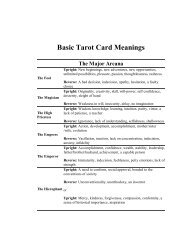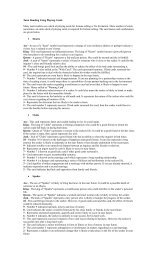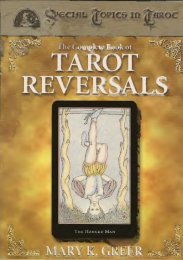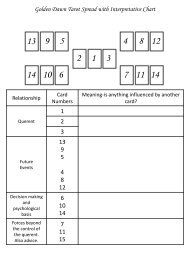Karmic Tarot: A Profound System for Finding and ... - myteacup
Karmic Tarot: A Profound System for Finding and ... - myteacup
Karmic Tarot: A Profound System for Finding and ... - myteacup
You also want an ePaper? Increase the reach of your titles
YUMPU automatically turns print PDFs into web optimized ePapers that Google loves.
The Nature of Readings<br />
119<br />
as upright when they are facing the reader. Options <strong>for</strong> upright/inverted cards are explained<br />
below.<br />
Whether the readee h<strong>and</strong>les the cards is at the discretion of the reader <strong>and</strong> may vary<br />
with the situation <strong>and</strong> amount of time available. The majority of readers prefer to offer the<br />
cards to the readee at some point prior to laying the spread, with a request that the cards be<br />
cut <strong>and</strong>/or shuffled. I offer the cards three times in a row, asking that they be cut. I prefer<br />
not to have the readee shuffle them. I stress that the cards may be cut in any fashion <strong>and</strong><br />
into as many stacks as the readee desires on each of the three offerings. You will develop a<br />
preference of your own on this facet of the reading, but whatever you do, keep this in mind:<br />
The degree to which both the reader <strong>and</strong> readee focus on the moment at h<strong>and</strong> is the major factor<br />
underlying the potential success of the reading. In case the readee has not sufficiently focused<br />
on what lies ahead, prior to this last moment be<strong>for</strong>e laying out the spread, offering the<br />
cards with a request <strong>for</strong> some action on their part will require them to consciously use of<br />
their mind in relation to the deck. This additional centering in the moment, however<br />
structured, guarantees at least some active participation by the readee.<br />
What of the option by some readers not to offer the cards at any time? This seems to be<br />
related to the reason most readers will not allow other readers to use their decks. They<br />
simply do not want the confusion of other energies involved with their cards or to risk<br />
physical damage to them. While I agree with this regarding other readers, I do not agree as<br />
regards to the reader/readee relationship. First of all, by definition, in any given reading<br />
you want the energies <strong>and</strong> impressions of the readee. It is not the reader’s reading, it is the<br />
readee’s. Second, after every reading, the cards should be shuffled <strong>and</strong> h<strong>and</strong>led in any way<br />
deemed necessary by the reader to neutralize the deck, <strong>and</strong> as the initial step in preparation<br />
<strong>for</strong> the next reading, be<strong>for</strong>e the cards are put away. This process should be adequate to<br />
offset any adverse effect of h<strong>and</strong>ling by the readee.<br />
Whether to offer the cards seems also to be a choice of in<strong>for</strong>mality or <strong>for</strong>mality. I<br />
prefer the active involvement of the readee in the entire process. Others may prefer more<br />
of a one-way process, with little active participation by the readee. However, under no<br />
circumstances should the cards be laid out by the readee. Their contact with the cards<br />
should be limited to the time prior to laying out the spread.<br />
<strong>Tarot</strong> is excellent <strong>for</strong> telling us what our questions really are, even when our conscious<br />
minds are convinced otherwise. The readee should be given the opportunity to address the<br />
questions that motivated them to come <strong>for</strong> a reading. As the spread itself will either agree<br />
or address other questions, it is not a problem if the readee declines to ask any questions<br />
initially. It should be pointed out that the more the readee reacts to the reader’s interpretations<br />
as the process unfolds, the greater the chances of receiving specific <strong>and</strong> detailed<br />
in<strong>for</strong>mation. Remember that if the readee is actively involved, the reading will be full of<br />
life, rich in meaning, <strong>and</strong> of great value. If, on the other h<strong>and</strong>, the readee is only passively<br />
involved, the reading may be relatively meager in meaning <strong>and</strong> value.<br />
The majority of my readings use more than one laying out of the cards. The <strong>Karmic</strong><br />
Spread is excellent <strong>for</strong> defining the questions, <strong>and</strong> I allow the first layout to help me feel<br />
the parameters of the issue(s) at h<strong>and</strong>, to focus the reading, <strong>and</strong> to establish objective<br />
rapport with the readee. Subsequent layouts then simply follow through on the leads of<br />
the previous layout(s), allowing the in<strong>for</strong>mation to become more <strong>and</strong> more specific. Always<br />
read the initial layout as a full-life spread. Then you can follow up with a layout using a<br />
contained time frame such as seven years, seven months, seven weeks, or even seven days.

















